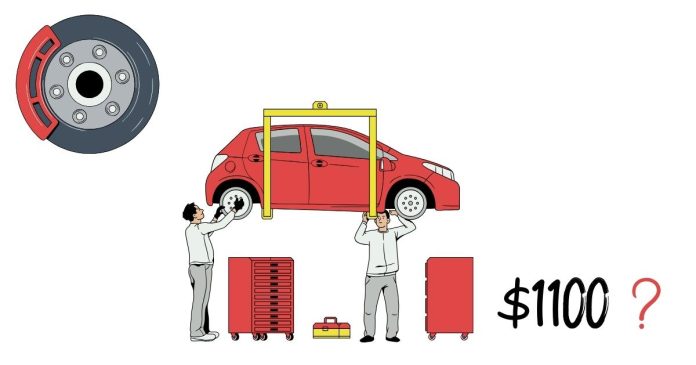If you’ve ever taken your car in for a brake service only to be hit with a $1100+ estimate for brake pads, you might be wondering, Is this normal? or Am I being ripped off? While the cost can seem outrageous, there are several factors that influence the price of brake repairs. Let’s break down why brake services can cost so much and what you can do about it.
Why Are Brake Repairs So Expensive?
- It’s More Than Just Pads
When you’re quoted $1100+ for a brake job, it often includes more than just replacing the pads. A full brake service typically involves:- Replacing brake pads
- Resurfacing or replacing rotors (often necessary for proper braking performance)
- Inspecting and possibly replacing brake calipers
- Flushing or topping off brake fluid
- Labor costs
Brake systems are critical for safety, so mechanics often recommend addressing all components to ensure the system works optimally.
- High-Quality Parts Are Costly
Not all brake pads are created equal. High-performance or specialized vehicles (luxury cars, sports cars, trucks) often require premium parts, such as:- Ceramic brake pads: Durable, quieter, and ideal for high temperatures but more expensive.
- OEM (Original Equipment Manufacturer) parts: These match the original factory specifications but cost more than aftermarket options.
If you drive a luxury or performance vehicle, expect to pay more for brake parts designed for your car’s specific needs.
- Labor Costs Add Up
Mechanics spend time removing the wheels, inspecting the brake system, installing new components, and testing the brakes. In areas with higher labor rates (like big cities), this can significantly inflate your repair bill. Brake jobs can take anywhere from 1 to 3 hours, depending on the complexity. With labor costs ranging from $75 to $150 per hour, this adds up quickly. - Dealer vs. Independent Shops
If you’re taking your car to a dealership, expect to pay more. Dealerships often charge higher labor rates and insist on OEM parts. While this ensures quality, it can push your bill well above $1000. Independent shops or specialty brake service centers can often do the job for less while still maintaining quality. - Hidden Issues Can Drive Up Costs
A simple brake pad replacement can turn into a more expensive repair if the mechanic finds additional problems, such as:- Worn or warped rotors
- Leaking brake fluid
- Failing brake calipers
- ABS (anti-lock braking system) issues
These repairs aren’t optional—ignoring them can compromise your car’s braking performance and safety.
Is $1100+ Normal for Brake Pads?
For a basic brake pad replacement, costs typically range from $150 to $300 per axle for most cars. However, when you add rotors, labor, and premium parts, it’s not uncommon for a full brake job to exceed $1000, especially for:
- Luxury brands like BMW, Audi, or Mercedes-Benz
- Trucks or SUVs with heavy-duty braking systems
- Performance cars with specialized brakes
If your car falls into one of these categories, a $1100+ quote might be reasonable. However, for standard vehicles, this could signal an upsell or overpriced service.
How to Save Money on Brake Repairs
- Shop Around
Get multiple quotes from different repair shops or mechanics. Independent shops are often more affordable than dealerships without compromising quality. - Ask About Aftermarket Parts
Aftermarket brake pads and rotors can save you a significant amount of money compared to OEM parts. Just ensure they meet safety and performance standards. - Do Routine Maintenance
Regular brake inspections can help you catch problems early and avoid costly repairs. Replacing pads before they wear down completely can prevent rotor damage, saving you hundreds. - DIY (If You’re Comfortable)
If you’re handy with tools and have some automotive knowledge, replacing brake pads yourself can save on labor costs. However, this is only recommended if you have the right tools, time, and confidence in your skills—your brakes are not an area to cut corners.
When Should You Splurge?
While saving money is important, cutting costs on safety-critical components like brakes can be risky. If you drive in challenging conditions (e.g., frequent rain, snow, or hilly terrain) or own a high-performance vehicle, it’s worth investing in quality parts and professional installation.
$1100+ for brake pads may seem excessive, but when you break it down, it often includes more than just the pads. Understanding what you’re paying for and why can help you make informed decisions. While there are ways to save, don’t sacrifice safety for cost. Your brakes are one of the most critical components of your car—make sure they’re in top condition, even if it means paying a bit more.
Have you experienced an expensive brake repair? Share your thoughts or tips for saving money in the comments!



